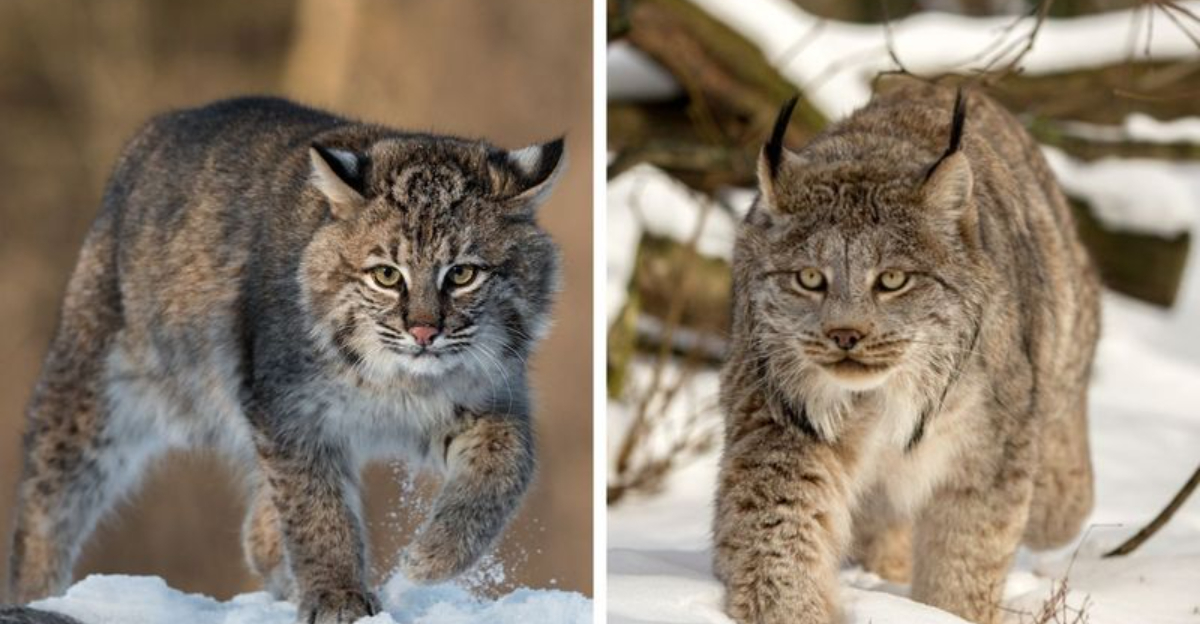📖 Table of Content:
Lynxes and bobcats, though closely related, exhibit unique differences that distinguish them within the wild cat family. These differences span across physical characteristics, habitats, and behaviors, each adaptation showcasing their survival prowess in diverse environments. Through exploring these contrasts, one gains a deeper appreciation for these elusive creatures. Discover the intriguing differences between lynxes and bobcats in size, appearance, habitat, and more, revealing the distinct niches each occupies in the natural world.
1. Size and Build
A lynx towers over its cousin with a commanding presence, standing about 24 inches tall at the shoulder. Weighing between 18 to 66 pounds, its long legs and substantial paws are well-suited for snowy terrains. In contrast, the bobcat’s more compact build stands around 22 inches tall and weighs between 12 to 33 pounds. Its smaller paws are perfect for varied terrains. These physical distinctions reflect their unique adaptations to different environments, with the lynx thriving in colder climates. This size disparity is crucial for their survival, dictating their hunting strategies and habitats.
2. Ear Tufts
Lynxes flaunt elegant ear tufts, often reaching up to 2 inches in length. These striking features not only enhance their keen hearing but also add to their enigmatic allure. Bobcats, with their subtler ear tufts less than an inch long, offer a more understated appearance. The length and prominence of these tufts play a role in communication and camouflage in their respective habitats. While the lynx’s ear tufts may help in snowy environments, bobcats blend seamlessly into varied landscapes. This difference is more than aesthetic—it reflects evolutionary paths tailored to distinct ecological niches.
3. Tail Characteristics
In the serene wild, the tail of a lynx tells its tale with a short, black-tipped flourish. This distinctive feature sets it apart, with a consistency that aids in silent movement through snow-laden landscapes. The bobcat, boasting a tail with a black tip on the upper side and a white underside, presents a more variegated appearance. These differences are more than skin deep; they reflect evolutionary adaptations. The lynx’s tail aids in balance and stealth in snowy terrains, while the bobcat’s unique patterning helps in diverse habitats. These tails, though small, speak volumes.
4. Paw Size
With paws akin to snowshoes, the lynx strides effortlessly across deep snow, its large paws spreading its weight for optimal navigation. This adaptation is crucial for hunting in icy environments. The bobcat’s paws, though smaller and compact, are no less impressive, tailored for agile movement across varied terrains. This difference in paw size underscores their distinct ecological roles. While the lynx’s larger paws facilitate survival in snow-laden regions, the bobcat’s compact paws offer versatility. Their paws, a testament to nature’s ingenuity, are perfectly adapted to their individual environments.
5. Coat Color and Markings
Adorned in a coat of subtle elegance, the lynx sports fur ranging from yellowish-brown to gray, with muted markings that blend seamlessly into snowy backdrops. This light coloration aids in camouflage, a silent guardian in winter wonderlands. The bobcat, conversely, wears a vibrant tapestry of brown or buff-colored fur, embellished with bold dark spots and stripes. This striking pattern is key for blending into forested and rocky terrains. These coats, though different in their artistry, serve a single purpose: survival. Each pattern is a masterpiece of adaptation, reflecting their habitats.
6. Habitat Preferences
In the embrace of dense boreal forests, the lynx finds its sanctuary, thriving in cold, snowy environments where its adaptations serve best. Its preference for these secluded areas ensures survival in harsh climates. The bobcat, ever the adaptable wanderer, thrives in various habitats—from forests to deserts and swamps, and even urban edges. This adaptability highlights its versatility and resilience. These habitat preferences aren’t mere choices; they’re evolutionary successes. The lynx and bobcat, though related, have carved out niches that ensure their survival across continents.
7. Diet
The lynx, a specialist predator, primarily hunts snowshoe hares, embodying a predator-prey relationship that dances in the snowy wilderness. This diet specialization ensures survival in its frosty domain. The bobcat, a culinary adventurer, boasts a more varied menu, feasting on rabbits, rodents, birds, and even small deer. This dietary flexibility mirrors its adaptable nature, allowing it to thrive in diverse environments. These dietary differences underscore their ecological roles. While the lynx’s focus narrows its niche, the bobcat’s broad palate expands its horizons, showcasing nature’s balance.
8. Behavior and Social Structure
In the solitude of night, the lynx prowls, a solitary hunter with minimal social bonds, driven by instinct and the rhythm of the wild. Its nocturnal nature ensures stealth and surprise. The bobcat, though also solitary, shows adaptability, with overlapping home ranges and a tendency for twilight activity. This crepuscular behavior maximizes hunting opportunities. These behavioral patterns resonate with their environments. The lynx’s solitary, nocturnal lifestyle suits its cold habitat, while the bobcat’s flexible social structure mirrors its varied environments. These behaviors, deeply ingrained, define their essence.
9. Conservation Status
Lynxes, particularly the Canada lynx, secure a spot under “Least Concern” on the IUCN Red List, a testament to their resilience despite threats from habitat loss and climate change. This status reflects conservation success yet warns of looming challenges. Bobcats share this classification with stable populations, thriving across North America. This shared status underscores successful conservation efforts and adaptability. However, it serves as a reminder of the delicate balance between wildlife preservation and human expansion. These statuses, though reassuring, highlight ongoing conservation needs to ensure their future.
10. Geographical Range
Roaming the vast expanses of northern realms, lynxes claim territories across Canada, Alaska, and parts of Europe and Asia. These regions, characterized by cold and snow, suit their adaptations. Bobcats, true to their adaptable nature, span a broad range from southern Canada through most of the contiguous United States to Mexico. This extensive range reflects their ecological versatility. These geographical differences highlight their evolutionary paths. While the lynx’s range is tied to cold environments, the bobcat’s adaptability allows it to flourish across diverse climates, illustrating nature’s adaptability.










